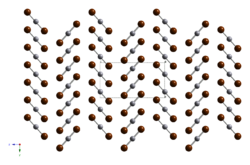Chemistry:Mercury(II) bromide

| |
| Names | |
|---|---|
| IUPAC name
Mercury(II) bromide
| |
| Other names
Mercuric bromide
| |
| Identifiers | |
PubChem CID
|
|
| RTECS number |
|
| UNII | |
| Properties | |
| HgBr2 | |
| Molar mass | 360.41 g/mol |
| Appearance | white solid |
| Density | 6.03 g/cm3, solid |
| Melting point | 237 °C (459 °F; 510 K) |
| Boiling point | 322 °C (612 °F; 595 K) |
| 0.6 g/100 mL (25°C) | |
| Solubility | 30 g/100 mL (25°C) ethanol |
| −94.2·10−6 cm3/mol | |
| Structure | |
| rhombic | |
| Hazards | |
| GHS pictograms |   
|
| GHS Signal word | Danger |
| HH300Script error: No such module "Preview warning".Category:GHS errors, HH310Script error: No such module "Preview warning".Category:GHS errors, HH330Script error: No such module "Preview warning".Category:GHS errors, HH373Script error: No such module "Preview warning".Category:GHS errors, HH410Script error: No such module "Preview warning".Category:GHS errors | |
| PP260Script error: No such module "Preview warning".Category:GHS errors, PP262Script error: No such module "Preview warning".Category:GHS errors, PP264Script error: No such module "Preview warning".Category:GHS errors, PP270Script error: No such module "Preview warning".Category:GHS errors, PP271Script error: No such module "Preview warning".Category:GHS errors, PP273Script error: No such module "Preview warning".Category:GHS errors, PP280Script error: No such module "Preview warning".Category:GHS errors, PP284Script error: No such module "Preview warning".Category:GHS errors, PP301+P310Script error: No such module "Preview warning".Category:GHS errors, PP302+P350Script error: No such module "Preview warning".Category:GHS errors, PP304+P340Script error: No such module "Preview warning".Category:GHS errors, PP310Script error: No such module "Preview warning".Category:GHS errors, PP314Script error: No such module "Preview warning".Category:GHS errors, PP320Script error: No such module "Preview warning".Category:GHS errors, PP321Script error: No such module "Preview warning".Category:GHS errors, PP322Script error: No such module "Preview warning".Category:GHS errors, PP330Script error: No such module "Preview warning".Category:GHS errors, PP361Script error: No such module "Preview warning".Category:GHS errors, PP363Script error: No such module "Preview warning".Category:GHS errors, PP391Script error: No such module "Preview warning".Category:GHS errors, PP403+P233Script error: No such module "Preview warning".Category:GHS errors, PP405Script error: No such module "Preview warning".Category:GHS errors, PP501Script error: No such module "Preview warning".Category:GHS errors | |
| NFPA 704 (fire diamond) | |
| Flash point | Non-flammable |
| Related compounds | |
Other anions
|
Mercury(II) fluoride Mercury(II) chloride Mercury(II) iodide |
Other cations
|
Zinc bromide Cadmium bromide Mercury(I) bromide |
Except where otherwise noted, data are given for materials in their standard state (at 25 °C [77 °F], 100 kPa). | |
| Infobox references | |
Mercury(II) bromide or mercuric bromide is an inorganic compound with the formula HgBr2.[2] This white solid is a laboratory reagent.[3] [2] Like all mercury salts, it is highly toxic.[2]
Preparation
Mercury(II) bromide can be produced by reaction of metallic mercury with bromine.[4]
Reactions
Mercury(II) bromide is used as a reagent in the Koenigs–Knorr reaction, which forms glycoside linkages on carbohydrates.[5][6]
It is also used to test for the presence of arsenic, as recommended by the Pharmacopoeia.[7] The arsenic in the sample is first converted to arsine gas by treatment with hydrogen. Arsine reacts with mercury(II) bromide:[8]
The white mercury(II) bromide will turn yellow, brown, or black if arsenic is present in the sample.[9]
Mercury(II) bromide reacts violently with elemental indium at high temperatures[10] and, when exposed to potassium, can form shock-sensitive explosive mixtures.[11]
References
- ↑ Template:Cite PubChem
- ↑ 2.0 2.1 2.2 PubChem. "Mercury bromide (Hg2Br2)" (in en). https://pubchem.ncbi.nlm.nih.gov/compound/24829.
- ↑ Elements, American. "Mercury Bromide" (in en). https://www.americanelements.com/mercury-bromide-7789-47-1.
- ↑ F. Wagenknecht; R. Juza (1963). "Mercury(II) bromide". in G. Brauer. Handbook of Preparative Inorganic Chemistry, 2nd Ed.. 2. NY, NY: Academic Press. pp. 1109.
- ↑ Horton, Derek (2004), Advances in Carbohydrate Chemistry and Biochemistry, Amsterdam: Elseveir Academic Press, pp. 76, ISBN 0-12-007259-9, https://books.google.com/books?id=E22gW9CbU_0C&q=%22mercury(II)+bromide%22&pg=PA76, retrieved 2008-05-29
- ↑ Stick, Robert V. (2001), Carbohydrates: The Sweet Molecules of Life, San Diego: Academic Press, pp. 125, ISBN 0-12-670960-2, https://books.google.com/books?id=-MtjsUMB6ogC&q=%22mercury(II)+bromide%22&pg=PA125, retrieved 2008-05-29
- ↑ Pederson, Ole (2006), Pharmaceutical Chemical Analysis, Boca Raton, Florida: CRC Press, pp. 107, ISBN 0-8493-1978-1, https://books.google.com/books?id=R7ZxXS5DZj8C&q=%22mercury(II)+bromide%22&pg=PT125, retrieved 2008-05-29
- ↑ Odegaard, Nancy; Sadongei, Alyce (2005), Old Poisons, New Problems, Rowman Altamira, pp. 58, ISBN 0-7591-0515-4, https://books.google.com/books?id=QLU0SVlruCMC&q=%22mercury(II)+bromide%22&pg=PA58, retrieved 2008-05-29
- ↑ Townsend, Timothy G.; Solo-Gabriele, Helena (2006), Environmental Impacts of Treated Wood, Boca Raton, Florida: CRC Press, pp. 339, ISBN 0-8493-6495-7, https://books.google.com/books?id=ENJL1UMdGTUC&q=%22mercury(II)+bromide%22&pg=PT361, retrieved 2008-05-29
- ↑ Bretherick, L.; Urben, P. G.; Pitt, Martin John (1999), Bretherick's Handbook of Reactive Chemical Hazards, Elseveir Academic Press, pp. 110, ISBN 0-7506-3605-X
- ↑ Bretherick, L.; Urben, P. G.; Pitt, Martin John (1999), Bretherick's Handbook of Reactive Chemical Hazards, Elseveir Academic Press, pp. 1276, ISBN 0-7506-3605-X
 |


